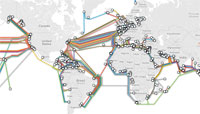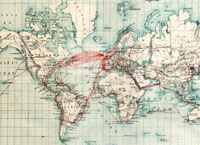For something so relatively new, we take the internet very much for granted. The first graphical web browser is less than 20 years old. Nevertheless, the internet seems ubiquitous in most of our lives. But on a world that is over 70% ocean, how do we communicate from one continent to another? Primarily, by sub-sea cable. TeleGeography has put together a map of the submarine cables that link us together on-line.
What I find interesting is that while the internet may be relatively new, undersea cable isn’t. The first successful transatlantic cable was laid by the SS Great Eastern in 1866. By the early 1870s undersea cables were run to Saudi Arabia, India, and Australia. By 1902, the US mainland was linked by undersea cable to Hawaii, Hawaii, Guam, the Philippines, Australia, New Zealand and Fiji. Antarctica is the only continent not yet linked by a submarine telecommunications cables. To he right is a map of undersea telegraph cables from 1901. Click the thumbnail for a larger image.



Have newer, fiber-optic cables been laid or do satelites handle internet traffic for the internet?
Apparently satellites can’t handle the bandwidth. The new fiber-optic cables seem to to be the system of choice.
Here is an article from about two years ago that goes into greater detail.
Today’s Incredible International Submarine Cable Systems
Do you know Hans Christian Andersen’s tale of the sea cucumber and the telephone cable? I think it fell in love. Or felt threatened. Or both! I shall have to look it up!
New to me. That sounds like a great tale. I’ll have to track it down.